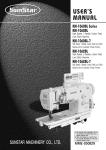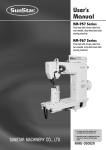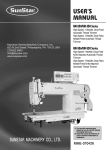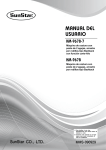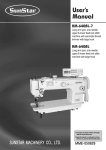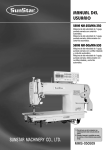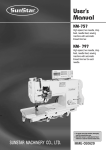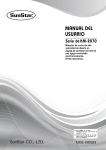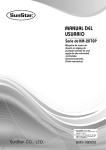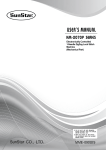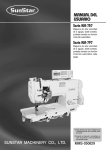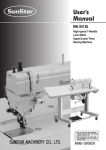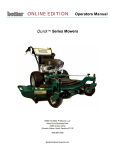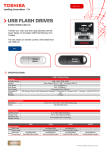Download User's Manual
Transcript
User’s Manual KM-250BL Series High speed, one needle, sewing machine with automatic thread trimmer 1) For proper use of the machine, thoroughly read this manual before use. 2) Keep this manual in a safe place for future reference in case the machine breaks down. SUNSTAR MACHINERY CO., LTD. MME-050509 lity a u tQ Besst Pricevice Be st Ser Be 1. Thank you for purchasing our product. Based on the rich expertise and experience accumulated in industrial sewing machine production, SUNSTAR will manufacture industrial sewing machines, which deliver more diverse functions, high performance, powerful operation, enhanced durability, and more sophisticated design to meet a number of user’s needs. 2. Please read this user’s manual thoroughly before using the machine. Make sure to properly use the machine to enjoy its full performance. 3. The specifications of the machine are subject to change, aimed to enhance product performance, without prior notice. 4. This product is designed, manufactured, and sold as an industrial sewing machine. It should not be used for other than industrial purpose. R SUNSTAR MACHINERY CO., LTD. Table of contents Safety rules for machine ...................................................................................................... 4 1. Specification..................................................................................................................... 8 1) Automatic thread trimming sewing machine............................................................................................................ 8 2) Servo motor................................................................................................................................................................ 8 3) 470 motor ................................................................................................................................................................... 8 4) 470 motor control....................................................................................................................................................... 9 5) Peripheral automation device (optional) ................................................................................................................... 9 2. Installation ...................................................................................................................... 10 1) Installation of machine head..................................................................................................................................... 10 2) Installation of automatic knee lifting solenoid and power switch box.................................................................... 10 3) Lubrication ................................................................................................................................................................ 11 4) Adjustment of belt tension........................................................................................................................................ 12 5) Installation of the program unit ................................................................................................................................ 12 6) Installation of the belt cover ..................................................................................................................................... 13 7) Location detector assembling and its control method. ............................................................................................ 13 8) Adjustment of location detector ............................................................................................................................... 14 9) Check for the stop position of the machine.............................................................................................................. 15 10) Reverse button function.......................................................................................................................................... 15 3. Adjustment of the Machine............................................................................................ 16 1) Inserting the needle .................................................................................................................................................. 16 2) Adjusting needle bar ................................................................................................................................................ 16 3) Adjusting timing of needle and hook ...................................................................................................................... 16 4) Adjusting oil flow in thread take up........................................................................................................................ 17 5) Adjusting oil flow of the hook ................................................................................................................................ 17 6) Inserting lower thread and adjusting thread tension ................................................................................................ 18 7) Routing the upper thread .......................................................................................................................................... 19 8) Adjusting the upper thread........................................................................................................................................ 19 9) Adjusting the height and pressure of the presser foot.............................................................................................. 20 10) Adjusting automatic knee lifter (optional) ............................................................................................................. 21 11) Adjusting stitch length ............................................................................................................................................ 21 12) Adjusting the height and slope of feed dog............................................................................................................ 21 13) Adjusting the trimming device ............................................................................................................................... 22 14) Adjusting knife tension........................................................................................................................................... 25 15) Exchanging movable knife .................................................................................................................................... 26 16) Exchanging fixed knife........................................................................................................................................... 26 17) Adjusting wiper....................................................................................................................................................... 27 18) Adjusting feed cam ................................................................................................................................................. 27 4. Causes of trouble and troubleshooting......................................................................... 28 1) Sewing machine troubleshooting ............................................................................................................................. 28 Safety Rules for Machine Safety labels in the manual are categorized into danger, warning and caution. Failure to follow the safety rules may result in physical injuries or mechanical damages. The safety labels and symbols are defined as follows. [The meaning of the safety labels] Danger Instructions here shall be observed strictly. Otherwise, the user will be killed or suffer severe physical injuries. Warning Instructions here must be observed, or the user could suffer fatal or severe physical injuries. Caution Instructions here should be observed, or the user could face physical injuries or mechanical damages. [The meaning of symbols] This symbol means a must-not. This symbol means a must for safety. This symbol means that an electric shock may be caused if the instruction is not followed properly. 4 1-1) Machine mobilization Only personnel with a full understanding of the safety rules should move the machines. The following directions must be observed when delivering the machines. ⓐ At least two persons should work together. ⓑ In case the machine should be transported, please wipe the oil covered on the machine to prevent accidents. Danger 1-2) Machine Installation Caution Because physical damage such as the functional obstacles and breakdowns are likely to occur according to the environment in which the machine is being installed. Therefore, the following preconditions should be fulfilled. ⓐ Please keep the order from top to bottom when unpacking the package. Especially, mind that the nail on the boxes. ⓑ Because machines are apt to be contaminated and corroded by dust and moisture, you should install the climate controller and should clean the machines regularly. ⓒ Keep the machines out of the direct rays of the sun. ⓓ Keep both sides and the backside of the machines off at least 50cm from the wall to secure enough space to repair. ⓔ Don’t run the machine near the places with the dangers of explosion. Don’t run the machine near the places with the dangers of explosion, including the places where the spraying product like aerosol are used in large quantities or oxygen are dealt with, unless the exact actions concerning the operation are guaranteed to avoid the explosion. ⓕ Because of the peculiarity of the machine, any illuminators are not equipped. So, users should install the lighting apparatus around the working area. [Note] The details about the installment of the machine are described in No. 2 Installation. 1-3) Troubleshooting Danger In need of troubleshooting, it should be done by the trained A/S engineer of our company. ⓐ Ahead of cleaning and repair, be sure to shut off the power supply. And wait for about 4 minutes till the machine discharges completely. ⓑ Even a part or all of the machine should not be modified without any consultation with our company. ⓒ In case of repair, you should change the damaged part into the standard article of our company. ⓓ After repair, please put again the safety cover disjointed while repairing. 5 1-4) Machine Operation Warning KM-250BL series are manufactured for industry use to sew textiles and other similar material. In case of running the machine, users should observe the following things. ⓐ Ahead of operating the machine, please read the manual and understand fully the details on its operation. ⓑ Don’t forget to put on the garment suited for the safe work. ⓒ Keep your hands or a part of the body away from the running part of the machine like a needle, hook, thread take-up spring and pulley etc. ⓓ Don’t remove. any kind of cover for safety while running the machine. ⓔ Be sure to connect the earthed line. ⓕ Before opening the electric box such as a control box, be sure to shut off the power supply and make sure that the power switch should be put on “off.” ⓖ When threading the needle or before checking after sewing, be sure to stop the machine. ⓗ Don’t switch on the power supply with the foot on the pedal. ⓘ Don’t run the machine when the cooling fan are not running. Be sure to clean the air filter in the control box once a week. ⓙ If possible, keep off from the strong electronic wave like a high frequency welding machine. Warning 1-5) Safety Device Warning Always start the machine with safety covers in place since fingers or hands could be injured or cut off by the belt. Turn off the power switch during check-ups or adjustments. ⓐ Safety Label: Suggestions while running the machine are stated. ⓑ Thread take-up spring cover: the device to prevent the human body from touching the thread take-up spring. ⓒ Belt cover: the device to prevent hands, feet and clothing from getting jammed by the belt. ⓓ Finger guard: the device to prevent fingers from contacting the needle. ⓑ ⓐ ⓒ ⓓ 6 1-6) Position of Caution Mark CAUTION 경 고 “Caution mark” is attached to the machine for safety. In case of starting to run the machine, read the directions of “Caution mark” carefully. [Position of Caution Mark] Do not operate without finger guard and safety devices. Before threading, changing bobbin and needle, cleaning etc. switch off main switch. 손가락 보호대와 안전장치 없이 작동하지 마십시오. 실, 보빈, 바늘교환시나 청소전에는 반드시 주전원의 스위치를 꺼 주십시오. CAUTION 경 고 Hazardous voltage will cause injury. Be sure to wait at least 360 seconds before opening this cover after turn off main switch and unplug a power cord. 고압 전류에 의해 감전될 수 있으므로 커버를 열 때는 전원을 내리고 전원 플러그를 뽑고 나서 360초간 기다린 후 여십시오. 1-7) Content of “Caution” Caution CAUTION 경 고 Do not operate without finger guard and safety devices. Before threading, changing bobbin and needle, cleaning etc. switch off main switch. 손가락 보호대와 안전장치 없이 작동하지 마십시오. 실, 보빈, 바늘교환시나 청소전에는 반드시 주전원의 스위치를 꺼 주십시오. CAUTION 경 고 Hazardous voltage will cause injury. Be sure to wait at least 360 seconds before opening this cover after turn off main switch and unplug a power cord. 고압 전류에 의해 감전될 수 있으므로 커버를 열 때는 전원을 내리고 전원 플러그를 뽑고 나서 360초간 기다린 후 여십시오. 7 1 Specification 1) Automatic thread trimming sewing machine KM-250BL Item KM-250BL KM-250BL-7S KM-250BL-7N Max speed Usage Max 3500spm Heavy Material (Average 3000spm) Max 3500spm Heavy Material (Average 3000spm) Max 3500spm Heavy Material (Average 3000spm) Max stitch Length Needle Presser Foot Height 0~7mm DB 1×#20~#23 0~7mm DB 1×#20~#23 0~7mm DB 1×#20~#23 Manual 5.5mm Knee 14mm Manual 5.5mm Knee 14mm Manual 5.5mm Knee 14mm 2) Servo motor MODEL VOLT WATT HERTZ SC55-1A ONE PFAHSE 110V 550W 50/60 Hz SC55-2A ONE PFAHSE 220V 550W 50/60 Hz SC55-3A THREE PHASE 220V 550W 50/60 Hz 3) 470 motor MODEL PHASE 1:1 1:1 3:3 PM470 3:3 1:1 3:3 8 HERZ 5 : 50Hz 6 : 60Hz 5 : 50Hz 6 : 60Hz 5 : 50Hz 6 : 60Hz 5 : 50Hz 6 : 60Hz 5 : 50Hz 6 : 60Hz VOLT 1 : 110V 2 : 220V 3 : 380V 4 : 110V / 220V 5 : 220V / 380V 4) 470 motor control MODEL PC470 VOLT 1 : 110V MODEL SUB CLASS A 001 2 : 220V 5) Peripheral automation device (optional) Optional device Model Usage AUTO KNEE LIFTING SYSTEM SPF-5 A solenoid operating structure where the presser foot gets lifted automatically with pedal reverse gear stage 1 operation. ·max. stroke: 10.3mm ·input voltage: DC 24V (DC 24 ~ 46V) ·induction at 10.3mm stroke: 26kg PRODUCTION COUNTER SCOUN-1 A counting device which indicates the completed quantity on the program unit panel, including added, subtracted, corrected or remaining quantity along with other performance rates. MATERIAL EDGE SENSOR SEDG-1 SEDG-2 A device that senses the edge or thickness of the sewing material to stop the machine without manual pedaling. Available in two types: SEDG-1 for edge sensing type and SEDG-2 for thickness sensing type. STANDING PEDAL SPDL-1 SPDL-2 An essential device when one person is operating multiple sewing machines. Has different pedals for acceleration, thread trimming, presser foot and ascending pedal. Types consist of SPDL-1 EDPL1 for fixed speed and SPDL-2 EDPL-2 for variable speed. 9 2 Installation Caution ▶Installation of the machine should be performed by a trained engineer. ▶Any electrical wiring must be performed by a qualified technician or agent. ▶The machine weighs over 32kg. At least 2 persons should carry out the installing work. ▶Plug in after the installation is complete. If the operator mistakenly steps down on the pedal with the plug in, the machine will start automatically and can cause physical injuries. ▶Connect the ground (earth) wire. An unstable connection may result in an electric shock or a malfunction. ▶Place the belt cover on top of the machine. ▶Use both hands when bending the machine backwards or returning it to the normal position. Using only one hand can lead to severe hand injuries the weight of the machine. 1) Installation of machine head Insert two machine head hinges into the bed holes. After aligning it with the rubber hinge cushion that is in the direction of the user. , stand the machine on the rubber [Figure 1] 2) Installation of automatic knee lifting solenoid and power switch box (KM-250BL-7N) Automatic knee lifting solenoid Power switch box A. Installation a) Attach the power switch box to the area of motor under the table. b) As can be seen in Figure2, attach connecter from the solenoid to controller box through the power switch box. (See, connecter part of controller box in page11-B) Controller box [Figure 2] 10 Caution ▶Plug in only after oil supply is finished. If the operator mistakenly steps on the pedal with the plug in, the machine will start automatically and can cause severe injuries. ▶When handling lubricants, wear protective glasses or gloves to avoid contact with your eyes or skin. Inflammation may be caused otherwise. Never drink lubricants since they can cause vomiting or diarrhea. Keep out of the reach of children. ▶Operate the machine only after adding oil when the machine is being used for the first time or has been left unused for a long time. 3) Lubrication Magnet A. Attach the magnetic chip remover Attach the magnetic chip remover in the accessory box to the oil pump in the bed. (See Figure 3) Do not use the magnet for other purposes. If the machine runs without the magnet, it will cause trouble or do damage durability. Oil pump OIL LOW B. Lubricating the oil fan a) Fill the lubricant up to the “HIGH” mark. (See Figure 4) b) The lubricant must be SUNSTAR’s oil provided exclusively for industrial sewing machines or SHELL’s Tellus C10. c) If the oil in use is down to the “LOW” mark, fill in to “HIGH” immediately. d) Once every two weeks is deemed the appropriate interval for oil refills. HIGH [Figure 3] [Figure 4] 11 4) Adjustment of belt tension After installing the motor, unfasten the fixing units , up and down and tension will be created to the belt due to motor failing by gravity. And fasten the fixing nut and then the fixing nut tightly. (See, Figure 5) [Figure 5] 5) Installation of the program unit A. Installation of Installation of automatic knee lifting solenoid a) Fix the bracket , on to the program unit , using 4 fixing nuts . b) Use 2 fixing bolts tightly. and 3 fixing nuts to fix the bracket [Figure 6] B. Installation of manual knee lifter a) Fix the bracket on to the program unit , using 4 fixing nuts . b) Then, use 3 fixing bolts fix. (See, Figure 7) to tightly [Figure 7] 12 6) Installation of the belt cover A. Attach belt cover A onto the machine body using fixing nut and washer . If the machine is laid down on its back, it will be easy to assemble. (See, Figure 8) [Figure 8] B. Attach belt cover B onto the table Make sure that the belt properly operates without interference from the belt cover “B”. [Figure 9] 7) Location detector assembling and its control method 0.5mm A. Installation of location detector a) Installing on the servo motor (in-built location detector) A sensor of location detector is attached to the back side of the arm. The appropriate clearance between the location detector and the pulley is 0.5mm. (See, Figure 10) [Figure 10] 13 B. Installation of 470 MOTOR Assemble parts in the order of marked number as can be seen in figure11. Then following the figure 12, make adjustments to place the photo film at the center of the photo interrupter, by moving the shaft to the right and left. Then, tighten the 2 fixing nuts using the hexagonal wrench. [Note] a) As can be seen on figure 12, make sure that the marks “DOWN” and “UP” face 4 the front when looking from the pulley side. b) Film adjustment is completed upon shipment. Pulley Speed sensor flim Fixing washer Fixing bushing Fixing nuts Location detector shaft L wrench Fixing nuts (2) of synchro shaft Synchro shaft Photo flim Photo interrupt Clearance adjusting bushing Fixing washer COVER PCB holder [Figure 12] [Figure 11] 8) Adjustment of location detector A. For in-built location detector Adjust the up-stop position of the needle such that the white carved sign on the pulley is in a straight line with the carved sign on the arm when the needle has stopped in the air. That adjustment can be made by loosening the pulley’s clamp screw on the side with N U carved signs and moving it sideways. Adjust the down-stop position of the needle such that the needle is on the point of moving up when the needle bar is at the lowest point. This adjustment can be made by loosening the pulley’s clamp screw on the side with N D carved signs and moving it sideways. (See, Figure 13&14) Up-stop [Figure 13] 14 Down-stop [Figure 14] B. For 470 motor (external location detectors) Turn the pulley manually to position the needle bar at the lowest point about to move back up. Then, loosen the fixed screws on the film as in Fig. 11 and align the “DOWN” film with the film adjustment baseline and the sensor housing baseline as in Fig. 15&16. Tighten the fixed screws just enough so that the film does not rotate. In the same way, place the thread take-up lever at the highest point, then loosen the fixed screws again and adjust the “UP” film as in shown the figure. Be careful that the “DOWN” film A that was tightened before does not move when adjusting the “UP” film. Film-Adjusting Arrow Setting Area Sensor Baseline Film Adjusting Base Sensor Base Setting the film when Setting the film when the the needle is in a up- thread take-up lever is at stop position the highest point [Figure 16] [Figure 15] Figure 16 enlarges the film position. As can be seen in figure 16, set the end of film-adjusting arrow to sensor base. 9) Check for the stop position of the machine White carved sign Check for the machine stop position after moving the needle up and down by pushing the reverse button. See whether the carved sign on the arm and the white carved sign on the pulley are aligned when the needle is in an up position. If not, adjustment to the photo film of the location detector or to the location of the magnetic holder will be necessary since there may be problems with the trimming. In other words, the needle’s up-stop position should be identical with the stop position of the needle bar after the trimming operation, which would signify that there is nothing wrong with the operation timing of the trimmer. (See Figure 17) (Refer to the explanation about the Adjustment of Location Detector on page 13.) Arm carved sign Reverse button [Figure 17] 10) Explanation of reverse button function Pressing the back tack button or reverse button during forward sewing will start reverse sewing immediately. When you stop the machine and restart it by stepping down on the pedal with the reverse button already pressed down, you can perform reverse sewing from the beginning. When the machine is in a “stop” mode, you can change the up-down position of the needle bar by pressing the reverse button. Lightly pressing the button once when the needle is in a down-stop position will stop the needle bar in a high position. Pressing the reverse button twice within less than a second when it is in an up-stop position will stop the needle bar in a low position. In short, the button delivers two functions: one for reverse sewing and the other for converting vertical position of the needle. (See Figure 18) Up-stop Down-stop [Figure 18] 15 3 Adjustment of the Machine Caution ▶Always turn off the power when mounting a needle. If the operator mistakenly steps on the pedal while the power is on, the machine will start automatically and can result in physical injuries. ▶When using clutch motor, be aware that the motor will continue to rotate for a while even after the power is switched off due to inertia. Start to work on the sewing machine only after the motor has come to a complete stop. 1) Inserting the needle Place the upper end of the needle closely adhered to the upper side of the stopper hole , with the needle groove facing inward. Fix the needle with a fixing screw . (See Figure 19) [Figure 19] 2) Adjusting needle bar 3) Adjusting timing of needle and hook As can be seen in figure 20, make the lower side of needle bar bushing meet the carved sign of hook marked in the needle bar and then loosen three hook fixing screws . Turn the loose hook so that the hook edge meets the needle center. When this is done, adjust the distance between the hook edge and the inner side of the needle groove to 0.05~0.1mm. Then, tighten three fixing screws again. 0.5mm As can be seen in figure 20, pull out the rubber cover of needle bar adjusting hole and turn the pulley to place the bar at the lowest part. Then, loosen the needle bar clamp screw and make the carved sign of the lowest bar meet the lower part of needle bar down- bushing by moving the bar. When is done, fix the clamp screw and clog the rubber cover . 0.05~0.1mm HOOK [Figure 20] 16 4) Adjusting oil flow in the thread take- up As in the figure 21, the more the point of the control plate of oil flow goes close to the center of hole of thread take-up crank shaft, the more oil comes. On the other hand, the more the point goes close to the corner of the link cam washer, the less oil comes. And when the point goes past the corner of the link cam washer, the oil does not come out. [Figure 21] 5) Adjusting oil flow of the hook Hook Bed 3~10mm A. Check oil flow a) After 3-minute idle operation of the machine, put the paper at the place as in figure 22. And rotate the machine for a 5 second. The amount of oil can be checked by the oil sprayed on the paper. b) Implement the test three times to find out whether it is short or abundant. The appropriate flow is one that does not exceed or lack based on the flow in the picture. ( If oil flow is not enough, the hook will not operate properly. If oil flow is too much, the cloth may be contaminated by oil.) Oil flow test paper Sprayed oil 0.5mm Minimum standard Oil fan Sprayed oil 1mm Maximum standard B. Adjusting oil flow Turning the oil adjusting screw clockwise increases the oil flow, and counter clockwise decreases the oil flow. Less More [Figure 22] 17 Caution ▶Turn off the power when adjusting the lower thread tension. If the operator mistakenly steps on the pedal, the machine will start automatically and can cause physical injuries. ▶When using the clutch motor, be aware that the motor will continue to rotate for a while after the power is switched off due to inertia. Start to work only after the motor has come to a complete stop. 6) Inserting lower thread and adjusting thread tension Weak Strong [Figure 23] A. Put the bobbin into the bobbin case . And insert the thread into the thread groove and then wind it from the back to the front of the tension adjusting plate spring . Turning the tension adjustment nut of the hook clockwise makes the lower thread tension stronger and counterclockwise makes it weaker. When hold the end of thread, make sure that the bobbin case should drop by gravity in order to adjust the lower thread tension. ( See Figure 23) B. Removing bobbin case With hand of the bobbin case , insert the bobbin case in to hook. Pull the hand when the hand is off) ( See Figure 23) 18 to remove the case. (the bobbin is removed Caution ▶Turn off the power switch when routing the upper thread. If the operator mistakenly steps on the pedal while switched on, the machine will start automatically and can cause physical injuries. ▶When using the clutch motor, be aware that the motor will continue to rotate for a while after the power is switched off due to inertia. Start to work on the sewing machine only after the motor has come to a complete stop. 7) Routing the upper thread Place the thread take-up lever to the highest position and insert the upper thread in the order of marked number as can be seen in figure24. [Figure 24] 8) Adjusting the upper thread A. Thread adjustment As can be seen in figure 25, turning the tension adjustment nut of the thread adjusting device clockwise makes the lower thread tension stronger and counterclockwise makes it weaker. Adjust the thread tension responding to the situation because adjustment of the thread tension changes according to sewing conditions such as the sewing material, used thread and stitch length. B. Adjusting the tension of the thread take up spring As can be seen in figure 25, insert the driver into the groove of the thread adjusting device . Turn clockwise to make the spring tension stronger and counter clockwise to make it weaker. C. Auxiliary thread adjustment As can be seen in figure 26, turning the thread tension adjustment nut clockwise makes the thread length after trimming shorter and counterclockwise makes it longer. The adequate length of upper thread after trimming is 30~40mm. Upper thread tension is weak Upper thread tension is strong Weak Good sewing Strong [Figure 25] [Figure 26] 19 D. Adjusting the thread release stroke a) When the trimming solenoid is in action, adjust to make the opening of the thread tension adjusting plate 1mm. b) For the adjustment, loose cable fixing nut of the thread release and wire. (See figure 27) [Note] If the plates are closely plates are closely adhered to each other, the upper thread length will be short and then the thread will release next. In addition, if the plates are widely adhered to each other, the plates will be open and be a cause for bad tension capability. 0.5~1mm-wide open Cable fixing nut of the thread release Wire [Figure 27] Caution ▶After disassembling and adjusting a safety device, always place it back to the original position and check whether it functions as intended. ▶Use both hands when pushing the machine backward or returning it to the original position. Due to the weight of the machine, your hand can get stuck in the machine if you should slip. ▶When adjusting the machine with the switch on, be sure to pay extreme caution. ▶Only trained engineers must perform troubleshooting or inspection of the machine. ▶For electrical repair or inspection, consult with qualified technicians or agent. 9) Adjusting the height and pressure of the presser foot A. As can be seen in figure 28, lift the rubber cover , drop the presser foot on the needle plate, and loosen the presser fastening screw to adjust the height of the presser bar. If the presser bar goes up, the presser foot will be low. If the presser bar goes down, the presser foot will be high. Make the distance between the upper side of the needle plate and the lower side of the presser foot 5.5mm with the presser foot lifter and then tightly fasten the bracket fastening screw. B. Adjusting the tension of the presser foot As can be seen in figure 28, turning the pressure adjustment screw clockwise increases the presser foot tension, and turning it counterclockwise makes it weaker. After adjusting, make sure to tighten the fixing nut . 20 Weak Strong 5.5mm Upper part of needle plate [Figure 28] 10) Adjusting automatic knee lifter (optional) A. Automatic knee lifter is attached to the machine upon shipment. When automatic knee lifter goes, the ascending amount of the presser foot is controlled by the crank shaft of automatic knee lifting solenoid . First, loosen the solenoid cover fixing screw and lift solenoid cover . The ascending amount of the presser foot falls, when the fastening screw of crank shaft of automatic knee lifting solenoid is loosened, the solenoid shaft is moved to the left, and the fixing screw is fastened. And it grows when the shaft is moved to the right and then the fastening screw is fastened. After the adjustment, assemble the cover again. Upon the shipment of machine, the ascending amount of the presser foot is fixed at 13mm when automatic knee lifter works. [Figure 29] 11) Adjusting stitch length As can be seen in figure 30, the number marked in the stitch length adjusting dial indicates the stitch width by mm. By moving left or right, set to the desired number. (Turning it to the right decreases the number of stitch width and turning to the left increases the number.) [Figure 30] 12) Adjusting the height and slope of feed dog A. Adjusting feed dog height Loosen the crank clamp screw and move the crank to adjust the height of feed dog. To adjust feed dog height, set the dial at the highest number. And when feed dog goes to the highest point, be aware that the height from the top of needle plate to the top of feed dog should be 1~1.2mm in the case of material sewing. ( See Figure 31) 1~1.2mm Heavy materials Feed dog [Figure 31] 21 B. Adjusting slope a ) First loosen the feed dog base clamp screw of the vertical roller crank and move the feed dog base up and down with a driver to adjust the slope. Turning the base clockwise makes the upper side of the feed dog up. Turning it counterclockwise makes the upper part down. (See figure 32) b) As can be seen in picture of figure 32, it is general to make the feed dog base covered sign set in parallel to the vertical roller crank. But to prevent parka ring, adjust the slope to higher direction as in picture of figure32. To reduce the delay of cloth, adjust the slope to lower direction as in picture of figure 32. c) Check the height of feed dog because the height of it changes after the adjustment of feed dog . Front Back Front is up Feed dog Adjusted Front is down [Figure 32] 13) Adjusting the trimming device A. Adjusting the trimmer driving part The part of trimmer cam is seen in figure 33. Trimming solenoid Fixed knife Trimming solenoid base Thread cover Trimming cam Movable knife Thread release cable Trimming lever Trimming final Slide arm Clutch Stopper Stopper lever lever [Figure 33] [Note] The trimming cam attached to the lower part runs the machine. Therefore in adjustment time, if the machine is run with trimming solenoid working, movable knife and needle conflict. So in that case, run the machine at the fixed trimming space (from the lower- upper side of needle bar) 22 B. Adjusting moveable knife and fixed knife a) As can be seen in figure 34, it is normal that the position of the fixed blade is at the center of fixed knife. b) Notice if part is widened, a thread is spitted into three pieces and then the thread falls out of needle after trimming. And a widened part causes trimming miss. Movable knife Fixed knife [Figure 34] C. Adjusting the trimmer driving part a) It is normal to assemble as in figure 35. b) Fix the trimming cam final crank to the trimming shaft as in the picture. c) Attach the stopper lever closely to bed in order to run trimming shaft smoothly enough not to let friction happen. 91mm Stopper lever Trimming cam final crank [Figure 35] D. Adjusting trimming solenoid a) Trimming solenoid stroke The normal solenoid stroke is 4.6mm as in figure36. Adjust the stroke with using trimming solenoid link. 4.6mm Clamp screw Trimming solenoid link [Figure 36] 23 b) Adjusting trimming solenoid First loosen the clamp screw of trimming solenoid link. Fix solenoid base clamp screw at a point where clutch lever moves right or left smoothly. When it is done, attach slide arm closely to the left. And then fix the clamp screw of trimming solenoid link with trimming solenoid stopper closely on the solenoid. Then, run the solenoid. The clearance between and the trimming cam crank and slide arm is 0.5mm as in figure 37, which is normal. Solenoid base Clamp screw of solenoid base Clamp screw Trimming solenoid link solenoid arm Trimming crant 0.5mm [Figure 37] E. Adjusting trimming cam. a) Manually turn pulley to align with red carved sign and arm carved sign . White point (The highest point of synchro) [Figure 38] b) With the trimming solenoid running on, turn the trimming cam clockwise. And fix the cam when is attached to the roller. (See figure 39) 0.5~1mm c) When the trimming cam crank turns back after stopping the operation trimming solenoid, the normal edge of cam roller is 0.5~1mm. (See figure 39) [Figure 39] 24 [Note] The position of trimming cam crank before its operation is normally like that in figure 40. When the position of roller changes, adjust with moving the stopper and follow the above a)~b). 0.6 mm [Figure 40] F. Adjusting knife position a) Adjusting movable and fixed knife As can be seen in figure 41, adjust the distance of movable and fixed knifes from the center of needle to be 7.5 mm and 5mm respectively. 7.5mm 5mm [Figure 41] b) Adjusting the stroke of movable knife With the solenoid running on, operate the machine. And then, movable knife rotate by the trimming cam. When stroke of the knife reaches the highest, it is normal the blade of movable knife moves 1.5~2mm from the edge of fixed knife. Adjust with moving the trimming lever. 1~1.5mm [Figure 42] 14) Adjusting knife tension. A. As can be seen in figure 43, it is normal movable and fixed knifes touch. B. When the trimming capacity is low due to use of thick thread, it is effective to strengthen fixed knife tension. Movable knife Fixed knife 3mm [Figure 43] 25 C. As can be seen in figure 44, loosen tension-adjusting nut of fixes knife with wrench box and then adjust with tension adjusting screw. After adjusting, tighten the nut using wrench box. Wrench box Movable knife Fixed knife [Figure 44] 15) Exchanging movable knife Manually turn pulley to place the thread at the highest and remove the needle plate. Then, as in the figure 45, loosen two fixing screws of the knife. To assemble, follow the reverse order of disassembling. [Figure 45] 16) Exchanging fixed knife A. As can be seen in figure 46, loosen hook holder clamp screw and then, pull out washer and hook holder. When is done, disassemble fixed knife clamp screw. To assemble, follow the reverse order of disassembling. [Figure 46] B. When the thread does not get trimmed or if the trimmed section of the thread is sloppy, please check the edge condition of the fixed knife. If the edge of the knife is too dull, sharpen the edge using oil stone or sand paper as in figure 47. Fixed knife Oil stone [Figure 47] 26 17) Adjusting wiper Manually turn pulley to make white arm carved sign align with white pulley carved sign. (The best position of thread take- up) Loosen two wiper shaft clamp screws of wiper base and push the link . When is done, adjust wiper shaft to make 2mm clearance between wiper and needle and then tighten the wiper shaft clamp screw . After that, loosen the wiper clamp screw to make clearance between the lower wiper and the needle end 2mm. Finally, fasten the wiper clamp screw tightly. (See figure 48, 49) [Figure 49] [Figure 48] 18) Adjusting feed cam A. To adjust the timing of feed dog and needle, move the feed cam up and down. It is normal that when manual turn of pulley drops feed dog and the upper feed dog adhere to the upper needle plate, attach the lower hole of needle to the upper feed dog. a) To enhance the needle tightening, move feed dog slightly slower than needle. To that end loosen feed cam clamp screw , turn the feed cam to the opposite direction and then fasten the clamp screw . b) To prevent delay of cloth , move feed dog slightly faster than needle. To that end, loosen feed cam clamp screw , turn the feed cam to the direction and then fasten the clamp screw . Needle Needle plate Feed dog (Normal) Feed dog (Fast) Feed dog (Slow) [Figure 50] 27 4 Causes of Trouble and Troubleshooting 1) Sewing machine troubleshooting No Symptom Checkpoints Root cause Corrective action Direction and height of Needle is inserted into wrong position Reinsert the needle correctly needle Needle is bent Bad timing of feed dog Change the needle Adjust the timing of feed dog Ascending level of needle bar Bad timing of needle and hook Adjust the timing of needle and hook Height of needle Bad timing of needle and hook Adjust the timing of needle and hook Gap between needle and hook Bad timing of needle and hook Adjust the timing of needle and hook Threading method Needle Wrong threading Bent needle or broken needle tip Thread the needle correctly Change the needle Needle 1 2 Needle breaks Thread breaks Direction and height of Needle inserted in the wrong position Insert the needle correctly needle Upper thread tension Lower thread tension Too tight upper thread tension Too loose lower thread tension Reduce tension of upper thread Reduce tension of lower thread Working capacity of take-up lever spring Loose upper thread Adjust take-up lever spring Direction and height of Needle is inserted into wrong direction needle bar 3 Sewing is skipped Reinsert the needle correctly and push in to its highest level Needle Threading Needle is bent Wrong direction Change the needle Insert the thread in the right way Ascending level of needle bar The timing between the needle and hook is bad Adjust the timing between the needle and hook Height of needle bar The timing between the needle and hook is bad Adjust the timing between the needle and hook Gap between the needle and the hook Needle and hook head are too far apart Adjust the timing between the needle and hook The length of the remaining upper thread is too short Bobbin case Idleoperation prevention spring When trimming, bobbin runs idly. So the upper thread is too short to go up. Change Idle-operation prevention spring Thread take up spring It is not strong to raise the lower thread Control the stroke of Thread take up spring Upper thread does not wind Too tight upper thread tension Reduce the tension of upper thread Too weak lower thread tension Enhance the tension of lower thread 5 Lower thread does not wind Too weak upper thread tension Too tight lower thread tension Enhance the tension of upper thread Reduce the tension of lower thread 6 Trimming miss The tension between the movable knife and the hook do not match Match the tension between the movable knife and the hook 4 28 Check tension of fixed knife No 6 Symptom Trimming miss Checkpoints Root cause Corrective action Blade side of movable and fixed knives Scratch and abrasion of movable and fixed knives Replace movable knife or fixed knife Direction of needle Needle is inserted into wrong direction Insert needle in to right place Check trimming cam and exchange knifes Lack of the meeting movable and fixed knifes Respond to the stroke of movable and fixed knifes Tension of the upper thread is strong Adjust Tension of the upper thread 7 Upper thread falls out when starting to sew Needle is too thick for thread Check for Needle top stop position Correct the thickness of the needle The position of Needle top and lower Find out needle top stop position 29





























